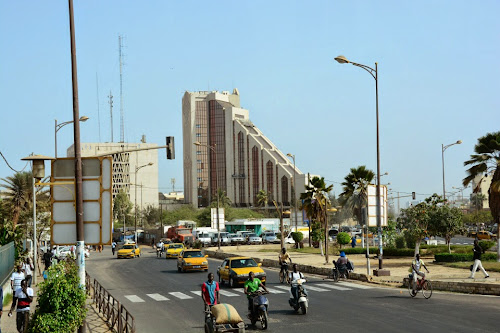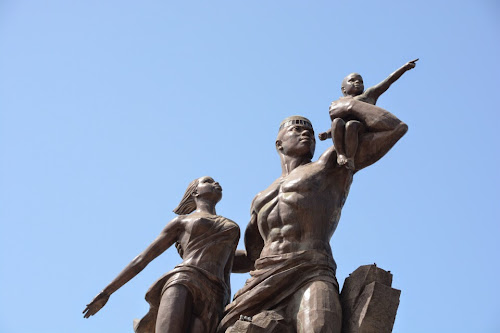Togo is so small and bereft of natural resources that the colonial powers didn't even bother to colonize the place until the Germans claimed it in 1884. In typical German fashion, they set up a very practical plantation system and built the roads, railroads and harbor necessary to export the agricultural products. Unfortunately for them, World War I came and with French Benin to the east and British Ghana to the west, they quickly lost Togo in what was the first Allied Victory of the war. France was given the mandate to govern the country and except for giving the Togolese a love of French Bread and a chance serve in the French Foreign Legion, which they did with honor, not much else happened until 1960 when independence was granted.
At first the educated and wealthy southern Togolese ran the country somewhat democratically, but that only lasted seven years before the Army took over and has run it ever since. Being so small and bereft of natural resources no one seems to care, sound familiar, but the Army has done a relatively good job in keeping the economy going as governments keep changing since the death Gnassinbe Eyadema, in 2005, the leader since 1967.
Not that this is a modern, well run country. It isn't. One half of the population lives below the international poverty level of $1.25 a day. Educational is compulsory for only six years and is of poor quality, especially in the rural areas. Life expectancy is 63 years of age which is pretty good considering there are less than 4 doctors per 100,000 population and most of them are in the five main cities.
While we arrived in the capital of Lome, we eschewed the city for a look at rural life and the practice of voodoo. Over 50% of the population still practices Voodoo and this little country prides itself on being at the epicenter of the religion of Vodun as it is called.
As we left the port in our well worn, non-air conditioned, bus complete with the requisite broken seats, dirty windows, and lack of PA system, but staffed by two young, enthusiastic, Togolese men, we saw a familiar sight and you thought I made up the bread story.
What was different here was that the road side stands very quickly gave way to the countryside and the lack of vehicles of any type was very noticeable. It seemed instead of selling things next to the road, people were growing things.
We reached the village of Agbodrafo where we were to meet the Chief and be introduced to our first Voodoo ceremony, see the house where the slaves were kept, and generally be able to poke around the village. To say it was pretty quiet for a late Saturday morning would be an understatement.

Q
Then the Chief arrived with his entourage and we were all ushered into to his ceremonial home.
There frankly isn't much to the ceremony. Some chanting and singing, spilling some water on the ground as a welcome, more chanting and singing, spilling some liquor on the ground and then, the question, "would anyone like their picture taken with the Chief?" The interesting thing was during this whole time the Chief does nothing, but sit and stand looking tranquil. He has an aide who does the ceremony. It turns out the Chief doesn't even communicate directly to his people in most cases, but through the aide.
We were able to go through the house, but it was pretty spartan. One thing, this Chief does like French wine.
We then were able to walk around the town, but things were pretty desolate until we heard a chattering and the voices of children coming from the beach area. Turns out most of the town was at Saturday church service by the water.
We left the town and headed for a fishing village which turns out is a real misnomer. The village is a collection of temporary grass huts built by a fishing tribe from Ghana who follow the fish as the season progresses. Despite it's bucolic location, life is very hard for these people and the day we were there marked the third day in a row the catch was meager.
Dinner that night was going to be a dish called Fu Fu which is mashed tuber to which any other grains and vegetables that are available are added.
This was one place where the children didn't seem happy.
If the men didn't catch any fish soon, they would abandon the village and move on. Without an abundant catch, they have no money to buy goods or eat anything other than roots.
By the way, this is our bus. I wasn't kidding.
One really can't go to the Ceremony of the Sacred Stone on an empty stomach. So we boarded our bus, left the fishing village to eat their Fu Fu, and headed to the Hotel Du Lac for lunch and a folkloric show. The lunch was good, the show was great, and the setting idllyic.
Now it turns out that Voodoo or Vodun and tourism only can go so far in an afternoon. The village is real, the voodoo priest was real and the stone is supposed to tell the future through it's color, but it only does that in September and to the faithful who venture into a forest behind the compound. Now we were told white folk were invited to attend, but on that day we had the same greating from the Chief, just with a bigger entourage, as in the first town and were let to view the opening to the forest, but nothing else. Major disappointment and it really felt like a rip off.


Then it was off to another village called Klouvidonnou for the traditional dance of the voodoo guardians of the night the Zangbetto. These objects look like haystacks and you are not supposed to see the feet of the dancers as they whirl and whirl around in circles. They are feared by the people and when they dance the drummers, singers and them often fall into trances. They are each accompanied by a handler who keeps them from falling into the crowd or worse the fire. Here the entire village came out to welcome us and take us to the dance area.
They even turn them over to show you no one is under the haystack. Then they right them and after more twirling fetishes magically appear.
It was a fascinating experience and we were amazed at how rapt the attention of the kids was kept during the performance. It was like they were seeing it for the first time. As usual they were just beautiful.
Then it was back to the bus and back to the ship. It was a long, hot, humid day, but a rewarding one despite the disappointment of the Sacred Stone. It probably was about as real as it could get on a tour off of a ship and we certainly were enjoying it. One thing about those Zangbeto dervishes...they kicked up so much dust the shower water ran tan for quite a while.








































































